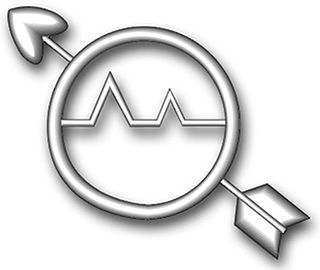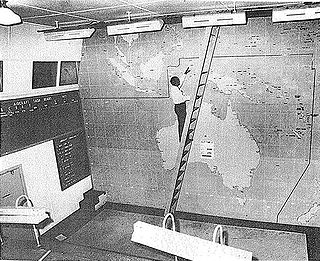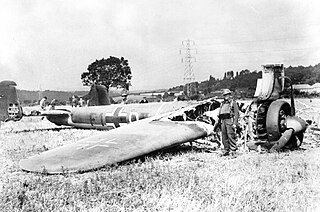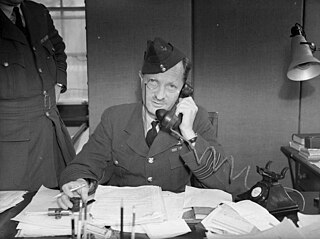
Chain Home, or CH for short, was the codename for the ring of coastal Early Warning radar stations built by the Royal Air Force (RAF) before and during the Second World War to detect and track aircraft. Initially known as RDF, and given the official name Air Ministry Experimental Station Type 1 in 1940, the radar units themselves were also known as Chain Home for most of their life. Chain Home was the first early warning radar network in the world, and the first military radar system to reach operational status. Its effect on the outcome of the war made it one of the most powerful weapons of what is today known as the "Wizard War".

RAF Bentley Priory was a non-flying Royal Air Force station near Stanmore in the London Borough of Harrow. It was the headquarters of Fighter Command in the Battle of Britain and throughout the Second World War. During the war, two enemy bombs destroyed a wooden hut near the married quarters, a blast from a V-1 flying bomb broke a few windows, the windows in the Officers' Mess were shattered by a V-2 rocket, and a Vickers Wellington crashed outside the Sergeants' Mess.

The Women's Auxiliary Air Force (WAAF), whose members were referred to as WAAFs, was the female auxiliary of the British Royal Air Force during World War II. Established in 1939, WAAF numbers exceeded 181,000 at its peak strength in 1943, with over 2,000 women enlisting per week.

Ground-controlled interception (GCI) is an air defence tactic whereby one or more radar stations or other observational stations are linked to a command communications centre which guides interceptor aircraft to an airborne target. This tactic was pioneered during World War I by the London Air Defence Area organization, which became the Royal Air Force's Dowding system in World War II, the first national-scale system. The Luftwaffe introduced similar systems during the war, but most other combatants did not suffer the same threat of air attack and did not develop complex systems like these until the Cold War era.

The Kammhuber Line was the Allied name given to the German night air defense system established in July 1940 by Colonel Josef Kammhuber. It consisted of a series of control sectors equipped with radars and searchlights and an associated night fighter. Each sector would direct the night fighter into visual range with target bombers.

Operations Specialist is a United States Navy and United States Coast Guard occupational rating. It is a sea duty-intensive rating in the Navy while most of Coast Guard OS's are at ashore Command Centers.

Adlertag was the first day of Unternehmen Adlerangriff, which was the codename of a military operation by Nazi Germany's Luftwaffe to destroy the British Royal Air Force (RAF). The operation came after Britain rejected all overtures for a negotiated peace with Germany. However, Adlertag and subsequent operations failed to destroy the RAF or gain local air superiority.

Bankstown Bunker, formerly known as Air Defence Headquarters Sydney, is a heritage-listed defunct Royal Australian Air Force (RAAF) operations facility, located on the corner of Marion and Edgar Street, in Condell Park, New South Wales, Australia. It was designed by the Allied Works Council and built from 1943 to 1944 by Stuart Bros Pty Ltd of Sydney. It is also known as Air Defence Headquarters Ruin Sydney (former), No. 1 Fighter Section Headquarters, 1FSHQ, Bankstown Bunker and RAAF No. 1 Installation Bankstown; No. 101 Fighter Sector. It was added to the New South Wales State Heritage Register on 18 November 2011.

Ramsey Grammar School is a coeducational comprehensive secondary school located in Ramsey, on the Isle of Man.

The Dowding system was the world's first wide-area ground-controlled interception network, controlling the airspace across the United Kingdom from northern Scotland to the southern coast of England. It used a widespread dedicated land-line telephone network to rapidly collect information from Chain Home (CH) radar stations and the Royal Observer Corps (ROC) in order to build a single image of the entire UK airspace and then direct defensive interceptor aircraft and anti-aircraft artillery against enemy targets. The system was built by the Royal Air Force just before the start of World War II, and proved decisive in the Battle of Britain.
Roslyn Air National Guard Station is a closed United States Air Force station. It was located in East Hills, New York, on Long Island. It was originally part of Clarence MacKay's Harbor Hill estate. It was closed in 2000.

The Battle of Britain Bunker is an underground operations room at RAF Uxbridge, formerly used by No. 11 Group Fighter Command during the Second World War. Fighter aircraft operations were controlled from there throughout the War but most notably during the Battle of Britain and on D-Day. Today it is run by Hillingdon Council as a heritage attraction with attached museum. The museum was opened in 1985, with an above ground visitor centre opened in March 2018.

The Hardest Day was a Second World War air battle fought on 18 August 1940 during the Battle of Britain between the German Luftwaffe and British Royal Air Force (RAF). On that day, the Luftwaffe made an all-out effort to destroy RAF Fighter Command. The air battles that took place on that day were amongst the largest aerial engagements in history to that time. Both sides suffered heavy losses. In the air, the British shot down twice as many Luftwaffe aircraft as they lost. However, many RAF aircraft were destroyed on the ground, equalising the total losses of both sides. Further large and costly aerial battles took place after 18 August, but both sides lost more aircraft combined on this day than at any other point during the campaign, including 15 September, the Battle of Britain Day, generally considered the climax of the fighting. For this reason, Sunday 18 August 1940 became known as "the Hardest Day" in Britain.

Plotters were employed on an early form of air traffic monitoring that played a vital role in World War II, including during the Battle of Britain, The Blitz and the bombing of British cities that followed. They worked at individual RAF stations' Sector Control Rooms or in the central Group Control Rooms that directed the operations of RAF fighters. The majority of plotters were female, members of the Women's Auxiliary Air Force (WAAFs).
Pip-squeak was a radio navigation system used by the British Royal Air Force during the early part of World War II. Pip-squeak used an aircraft's voice radio set to periodically send out a 1 kHz tone which was picked up by ground-based high-frequency direction finding receivers. Using three HFDF measurements, observers could determine the location of friendly aircraft using triangulation.
The RAF Training Flying Control Centre was an early form of Aircraft Area Control Centre, the first of its kind in the world. It was situated at Ramsey Grammar School, Isle of Man.

The AMES Type 7, also known as the Final GCI, was a ground-based radar system introduced during World War II by the Royal Air Force (RAF). The Type 7 was the first truly modern radar used by the Allies, providing a 360 degree view of the airspace around the station out to a distance of about 90 miles (140 km). It allowed fighter interceptions to be plotted directly from the radar display, a concept known as ground controlled intercept, or GCI.

Exercise Ardent was a massive military exercise carried out by the Royal Air Force (RAF) over the United Kingdom in 1952. It pitted Bomber Command against a combined defensive force from Fighter Command, Fleet Air Arm, several squadrons of the Royal Canadian Air Force (RCAF) and additional units from the USAF and various European NATO allies. Additionally, various British Army and Territorial Army anti-aircraft forces were included, along with the Royal Observer Corps and their RAF liaisons. Over 200,000 members of the various armed forces were involved in total, with around 1,300 aircraft flying over 7,500 sorties. It was the largest air exercise held since World War II, besting even the multinational Operation Sky Shield of the early 1960s.
The Seeburg plotting table was a mechanical plotting table used by Nazi Germany in their operation rooms to track aircraft and coordinate operations during World War II.

Group Captain Alfred Basil Woodhall was a British senior officer who served in the Royal Air Force (RAF) during the Second World War. He was a senior controller in the Battle of Britain and the Siege of Malta.
















